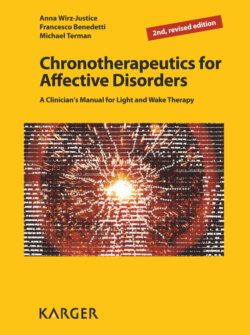Читать книгу Chronotherapeutics for Affective Disorders - M. Terman - Страница 14
На сайте Литреса книга снята с продажи.
1.4 Principles of Sleep Regulation
ОглавлениеThe timing and physiological structure of sleep are consequences of interactions between the circadian pacemaker (process C) and a homeostatic process of sleep pressure that increases with the duration of wakefulness and dissipates during sleep (process S) [20] (fig. 7). In healthy subjects, process S builds up during waking until it intersects with the phase of process C appropriate for sleep onset. Thereafter, the exponential decline, associated with slow wave sleep, intersects with the phase of process C appropriate for waking up.
This model proposes that abnormalities in either process S or C can predispose an individual to depression [21]. For example, the normal daytime accumulation in sleep pressure may be deficient, but with sleep deprivation it will continue to accumulate over the next day. The antidepressant effect of one night without sleep (wake therapy) can be seen in terms of normalisation of process S to the usual level that precedes sleep (fig. 8). Similarly, process C can vary abnormally in phase position, amplitude, or both. These variations will determine when process S intersects the threshold for sleep onset and wake-up time (producing sleep disturbances in depressive patients, such as sleep onset insomnia with early morning awakening, or hypersomnia). Thus, the chronotherapeutic focus is on strategies that nor-malise process C. Appropriately timed light therapy can phase shift the circadian clock, increase its amplitude, or both (fig. 8).
